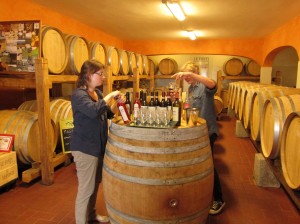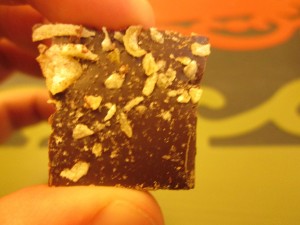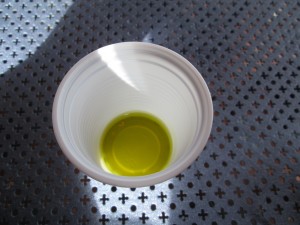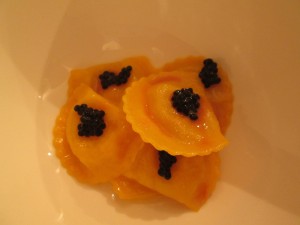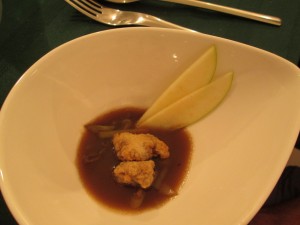When I enrolled in this course, I had never reflected on taste in any way. I was used to just eating things and tasting them as they entered my mouth. In reality, there are two notions of taste. The first is a physiological notion, and says that while taste buds may vary from person to person, we all can detect 5 tastes, which are salty, sweet, bitter, sour, and umami. The other is a multi-modal perception. This suggests that taste is an experience that utilizes all of the senses to enhance the dining experience along with memories and certain emotional experiences. This means that you may even taste things in a food that are not actually in a food. For example, you may taste vanilla in a food that doesn’t actually have vanilla in it because there is an artificial version of vanilla that tastes just like the real thing, but you remember what vanilla tastes like so your memory influences your taste. Thus, learning how to properly taste changes the dining experience into a process where one must taste their food in the correct manner to experience the most pleasure as well as respect the preparation of the food and its origins. This is what we call active dining.
Wine
During our five visits to wine producers where we did tastings, we learned how to properly go about tasting a wine. The first step is to use your eyes. Do you have a red wine or a white wine? Is it a rosé? Just looking at it will already prepare you for the rest of the experience. The next step is to use your nose. You put the glass up to your nose and smell the wine. Many different aromas get released and you begin to get a feel for the wine. Next, you stir the wine using the glass and then smell that, because the motion of the wine could release some different aromas than just having it stationary under your nose. Finally, you put the wine in your mouth and swirl it around, after which you can choose to swallow it or spit it out. The tasting process is now over, and you would use descriptors to define what you think the wine tasted like. This may seem like quite a long process to just taste a wine, but involving as many of your senses as you can leads you to a fuller experience in tasting a wine as well as a better understanding as to what may have gone into the wine. Being in the Chianti region of Tuscany, we mostly tasted Chianti Classicos. To be a Chianti Classico, the wine needs to be made from at least eighty percent sangiovese grapes, with the remaining twenty percent being up to the producer as long as they are red grapes. The sangiovese grapes give the wine a bit of an acidity making the Chianti Classico a great wine to be drank while eating a meal, and not so great for being drank without food.
Chocolate
Chocolate, on the other hand, is a completely different game. When we visited de Bondt’s chocolate shop, we learned that tasting chocolate is a very slow experience, and it has a lot to do with the chocolate maker and how they created the chocolate and how they wanted it to be tasted. For example, the first chocolate we tasted with de Bondt was a layer of milk chocolate on top of a layer of dark chocolate with some salt crystals scattered throughout. Generally for tasting chocolate, you put it in your mouth and let it melt away, and this was especially emphasized with de Bondt because he wanted the different layers to be hitting different parts of the mouth at the same time, with the salt crystals being extra explosions of flavor whenever you got to them. We see this in the picture, which is a different bar of chocolate containing lemon and limette, but the concept is really the same. This was not an experience I was used to, because I, like most people that I know, usually just bite at the chocolate until it is small enough to swallow and that’s it. I always thought that chocolate tasted good, but since I wasn’t tasting the chocolate correctly, I was missing out on a lot of the experience. Tasting de Bondt’s chocolate correctly involved my nose more because I could smell the chocolate through my mouth, I used my ears to hear the crunches when I took a small bite or came across one of the salt crystals, and I used my tongue to move the piece of chocolate around my mouth. The entire experience was heightened solely by the extra usage of my senses.
Olive Oil
Finally, we went about tasting extra virgin olive oil. This was perhaps the strangest tasting we did. First, just as we did with the wine, we looked at and smelled the olive oil. We learned that the greener the oil is the better it is. To go along with the green color, it has to give off certain aromas such as that of grass or other plants. It really needs to smell green to be a good extra virgin olive oil. After looking at it and smelling it, you put some in your mouth and then inhale a bit of air on top of it. You then let it sit in your mouth, which is similar to how we taste chocolate. Letting the oil sit there with the air really brings out the flavors of the oil. Understandably, many of the flavors between the three foods are not shared, but some definitely are. For example, for many of the red wines we tasted we used the descriptors of red fruits. This is interesting because the red fruits never actually go into the wine. On the other hand, in a chocolate bar with flavoring such as raspberry chocolate bars, you get some of the same flavors of the red fruits, but they have actually gone into the chocolate bars. Similarly, wines and olive oils can both taste peppery. Ultimately, learning how to taste properly and being able to use the proper descriptors for what you eat and drink refines your palate, and in turn increases your pleasure while eating because you taste in such a way that allows you to experience everything that the food was meant to give you.
Active Dining
Learning all of this about tasting and flavors led us to the concept of active dining. Active dining involves using all of your senses during a meal to really appreciate what you are being fed. We saw this at L’Imbuto where we had had 12 courses that covered a wide range of foods. Two of the dishes are shown in the pictures, one of which is ravioli filled with whiskey and potatoes with caviar and top, and the other is fried brain with apples and artichokes. We also saw this in the documentary we watched about El Bulli, and how Ferran Adriá prepared his dishes. It took six months of preparation to come up with the dishes for the next year, and even after that, Adriá was still changing dishes up until the moment they left the kitchen. He wanted the dishes evoke several different feelings from the diners, especially in such a way that they would use all of their senses to figure out what was behind it and what they thought Adriá wanted the dish to evoke. We saw very similar approaches to dining with Massimo Bottura and René Redzepi as both of them are chefs who specialize in the movement of nouvelle cuisine, which emphasizes creativity on the chefs’ part as well as lightness and using the freshest ingredients possible, among a few other points. The main idea is that they are all transforming the dining experience to involve the diners more, and to make them work a bit harder so that they can fully experience their meal. This accentuates the idea that tasting a food is more than just putting it in your mouth and swallowing it. It is a full process that involves all your senses, and on top of this, it can be a different process for different foods, so you need to make sure you are tasting everything in the proper way otherwise you aren’t making the most of your dining experiences. On this note, properly tasting food leads to having a certain respect for the food you are eating and what has gone making it and even producing the actual ingredients. On top of this, you are respecting yourself in the sense that you are respecting your sense of pleasure by making sure you get the most pleasurable dining experience by tasting all of the components of your meal properly. This is important because it can truly become a way of life. Tasting correctly gives you the power to relate to tastes in many different ways that you would not have been able to before. For example, Valeria from Le Cinciole told us that one of the wines tasted like childhood to her despite the fact that none of us understood what that really meant. She is able to do so because after tasting so many wines, the flavors that she comes across evoke memories from her brain that correspond to what she is tasting, making the experiences that much deeper and more pleasurable for her. Ultimately, becoming an active diner enhances the eating and drinking experiences by involving all of your senses and even your memories, fully immersing you in what you eat and drink.

